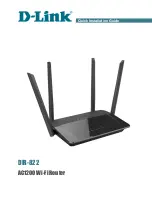
DGS-3200 Series Layer 2 Gigabit Managed Switch CLI Manual
439
How ARP Spoofing Attacks a Network
ARP spoofing, also known as ARP poisoning, is a method to attack an Ethernet network which may allow an attacker to
sniff data frames on a LAN, modify the traffic, or stop the traffic altogether (known as a Denial of Service – DoS attack).
The principle of ARP spoofing is to send the fake, or spoofed ARP messages to an Ethernet network. Generally, the
aim is to associate the attacker's or random MAC address with the IP address of another node (such as the default
gateway). Any traffic meant for that IP address would be mistakenly re-directed to the node specified by the attacker.
IP spoofing attack is caused by Gratuitous ARP that occurs when a host sends an ARP request to resolve its own IP
address. Figure-4 shows a hacker within a LAN to initiate ARP spoofing attack.
Figure-4
In the Gratuitous ARP packet, the “Sender protocol address” and “Target protocol address” are filled with the same
source IP address itself. The “Sender H/W Address” and “Target H/W address” are filled with the same source MAC
address itself. The destination MAC address is the Ethernet broadcast address (FF-FF-FF-FF-FF-FF). All nodes within
the network will immediately update their own ARP table in accordance with the sender’s MAC and IP address. The
format of Gratuitous ARP is shown in the following table.
Table-5
Destination
address
Source
address
Ethernet
type
H/W type
Protocol
type
H/W
address
length
Protocol
address
length
Operation Sender
H/W
address
Sender
protocol
address
Target H/W
address
Target
protocol
address
(6-byte)
(6-byte)
(2-byte)
(2-byte)
(2-byte)
(1-byte)
(1-byte)
(2-byte)
(6-byte) (4-byte)
(6-byte) (4-byte)
FF-FF-FF-FF-FF-FF 00-20-5C-01-11-11
806
ARP reply
00-20-5C-01-11-11
10.10.10.254
00-20-5C-01-11-11
10.10.10.254
Ethernet Header





































